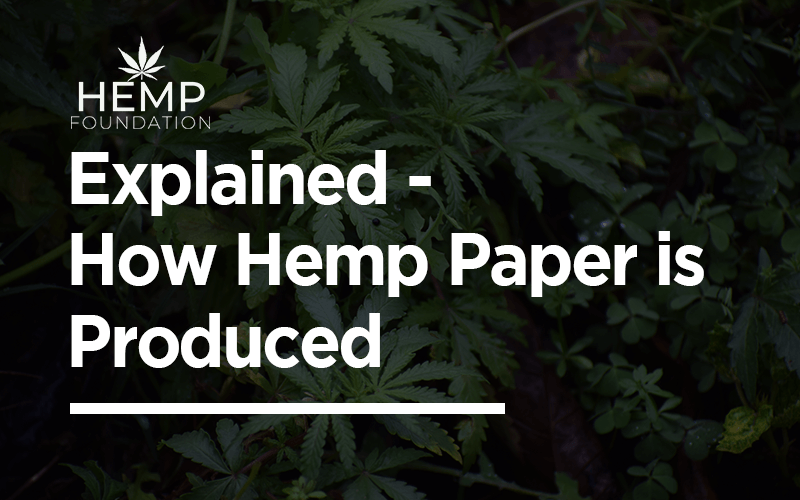Explained – How Hemp Paper is Produced
[vc_row][vc_column][vc_column_text]Paper produced entirely or mostly from the fibers of the hemp plant is known as hemp paper. Hemp or industrial hemp is the non-narcotic kin of drug cannabis or marijuana. Hemp belongs to the same plant species Cannabis Sativa L as marijuana.
It’s difficult to understand how hemp paper is produced unless you understand the history of it because the method has evolved over the decades.
This botanical relationship had led to hemp being outlawed in much of the world in the 20th century. Thankfully, many countries have now corrected this human blunder. Hemp has been decriminalized since it does not possess any psychoactive properties.
Tetrahydrocannabinol (THC), the psychoactive element is present in high concentration in drug cannabis: 7.5 to 10 percent or higher. This gives marijuana its capacity to cause the so-called high. THC presence is limited to 0.3 percent or less in hemp, which means this plant has no psychotropic effects.[/vc_column_text][/vc_column][/vc_row][vc_row][vc_column][vc_column_text]
Hemp Paper Antiquities
Historians inform us that the world’s earliest paper was made by the Chinese from hemp fibers nearly 2,200 years ago around 150 BCE. It spread from China to the Middle East and then to the rest of the world. All paper used in the world was hemp paper till 1883.
The first printed Bible, known as the Gutenberg Bible or the 42-line Bible, used hemp paper. Mark Twain’s novels also got printed on hemp paper. It was hemp paper that Thomas Paine used to print the leaflets that spread the idea of American independence.
The first two drafts of the American Declaration of Independence were written on hemp paper. The first version of the US Constitution also got drafted on hemp paper. The current usage of hemp paper, however, is restricted mostly to specialty paper.
[/vc_column_text][tm_image align=”center” md_align=”center” image=”10694″][vc_column_text]
Ancient Chinese paper
[/vc_column_text][/vc_column][/vc_row][vc_row][vc_column][vc_column_text]
How Hemp Paper Is Made Today?
Fibers sourced from hemp stalks are among the strongest plant fibers in tensile strength. Hemp stalks yield two types of fibers: long bast fibers and short hemp hurds or pulp fibers. Longer bast fibers come from the outer layer of the hemp stem while hemp hurds refers to the woody inner core.
It is possible to use both types of fibers for the production of hemp paper. Paper made from the long bast fibers is crumbly, thin, and coarse. Paper made from hemp hurds or pulp is thicker and softer. The production process of paper from hemp pulp is also easier.
Hemp paper like traditional paper needs the pulping of the fibers into a slurry. This is easier to do using hemp hurds. The first step is to separate the pulp from other plant matter. The next step is to soak the refined pulp in clean water and pound it to get a pulp slurry.
In industrial papermaking, some additives are used for the slurry. The next step is to remove the excess water from the slurry. The paper machine spreads the slurry on a mobile continuous screen for the water to be drained by gravity or vacuum.
Then the wet paper goes through pressing to be dried. The final outcome is a roll of paper. Cutting the rolls into different paper sizes using mechanized cutters is often a separate enterprise that paper mills do not undertake.
One of the major differences between handmade paper and industrialized paper constitutes in the edges. The machine-cut paper has smooth edges. Wooden frames called deckles are used to cut the paper into different sizes in handmade paper. That leaves the edges slightly uneven. Known as deckle-edges, they indicate that the paper is handmade.[/vc_column_text][tm_image align=”center” md_align=”center” image=”10695″][vc_column_text]
Producing handmade hemp paper
[/vc_column_text][/vc_column][/vc_row][vc_row][vc_column][vc_column_text]
Benefits of Hemp Paper
Knowing how hemp paper is made isn’t enough. You need to know the benefits.
Hemp remained the primary source of papermaking for 2000 years until wood pulp substituted it in the 20th century. The renewed interest in using hemp for papermaking is a result of a growing consciousness about several environmental hazards of using tree paper.
Hemp is nature’s solution to all the problems associated with the use of wood paper. Hemp has considerably higher renewability than trees as a source for paper. The quantity of paper generated from one acre of hemp is equal to what four to 10 acres of trees can produce over a period of 20 years.
The reason behind this productivity is the higher cellulose content in hemp stalks. Cellulose is the main ingredient of paper. Hemp stalks contain up to 85 percent cellulose in comparison to about 30 percent cellulose in wood.
The use of chemicals to remove the non-cellulose contents is significantly higher in the case of wood as nearly 70 percent of the wood is non-cellulose. Also, trees need 20 to 80 years to mature. Hemp, in contrast, is ready for use in four months.
Hemp paper is also significantly more durable than paper produced from wood pulp. It does not yellow and cracks as easily as wood paper. Ancient remnants of hemp paper testify to its durability. Hemp paper is a natural substitute for the special acid paper used for conserving important documents.[/vc_column_text][/vc_column][/vc_row][vc_row][vc_column][vc_column_text]
Hemp Paper and the Environment
If Mother Earth had a choice, she would choose hemp paper over wood paper. Hemp paper is far more environmentally-friendly than tree paper. Deforestation is a case in point. The world lost 502,000 square miles or 1.3 million square kilometers of forest cover between 1990 and 2016.
The National Geographic published this data quoting a World Bank report. The effects of deforestation are grim and far-reaching. It is one of the primary causes of global warming and climate change. To destroy a forest is also to release the carbon dioxide sequestered there into the atmosphere.
In addition, fewer trees imply a reduced capacity for carbon dioxide absorption. Forests are also critical for the natural water cycle to be maintained. Further, there is the loss of natural habitats for a wide range of flora and fauna. That endangers their existence and threatens the planet’s natural biodiversity.
Using hemp instead of trees for papermaking is one eco-friendly response to the problem of deforestation. In addition to reducing the need to fell trees, hemp also regenerates the soil.
Paper companies planting eucalyptus after felling all the trees in an area does not compare with hemp.
Another environment-friendly aspect of hemp paper is that it needs no bleaching. The production of hemp paper thus eliminates the chances of contaminating water with dioxin or chlorine, as paper mills do. The chemicals used in separating hemp fibers from the lignin are far less toxic.
The only plant better suited for papermaking than hemp is kenaf. However, kenaf does not grow as fast as hemp and does not produce as much fiber as hemp does. Hemp has the potential to meet all our paper needs, but kenaf does not.[/vc_column_text][/vc_column][/vc_row][vc_row][vc_column][vc_column_text]
How Hemp Paper is Made: Present and Future
Contemporary use of hemp paper is mostly limited to the production of specialty paper such as cigarette paper and cosmetic tissue paper. Only a few companies in Europe and North America have experimented with producing writing paper from hemp.
One of the reasons behind the resistance to using hemp as a source for writing paper could be the costs involved in changing the machinery. About 40 to 60 percent of retooling is necessary to switch from tree paper to hemp paper.
Gmund, a large papermill in Germany is increasingly producing large batches of hemp paper varieties, including writing paper. Other paper mills around the world need to undertake the equipment change to produce more hemp paper unless we want to be left with no more trees to fell.[/vc_column_text][/vc_column][/vc_row]




